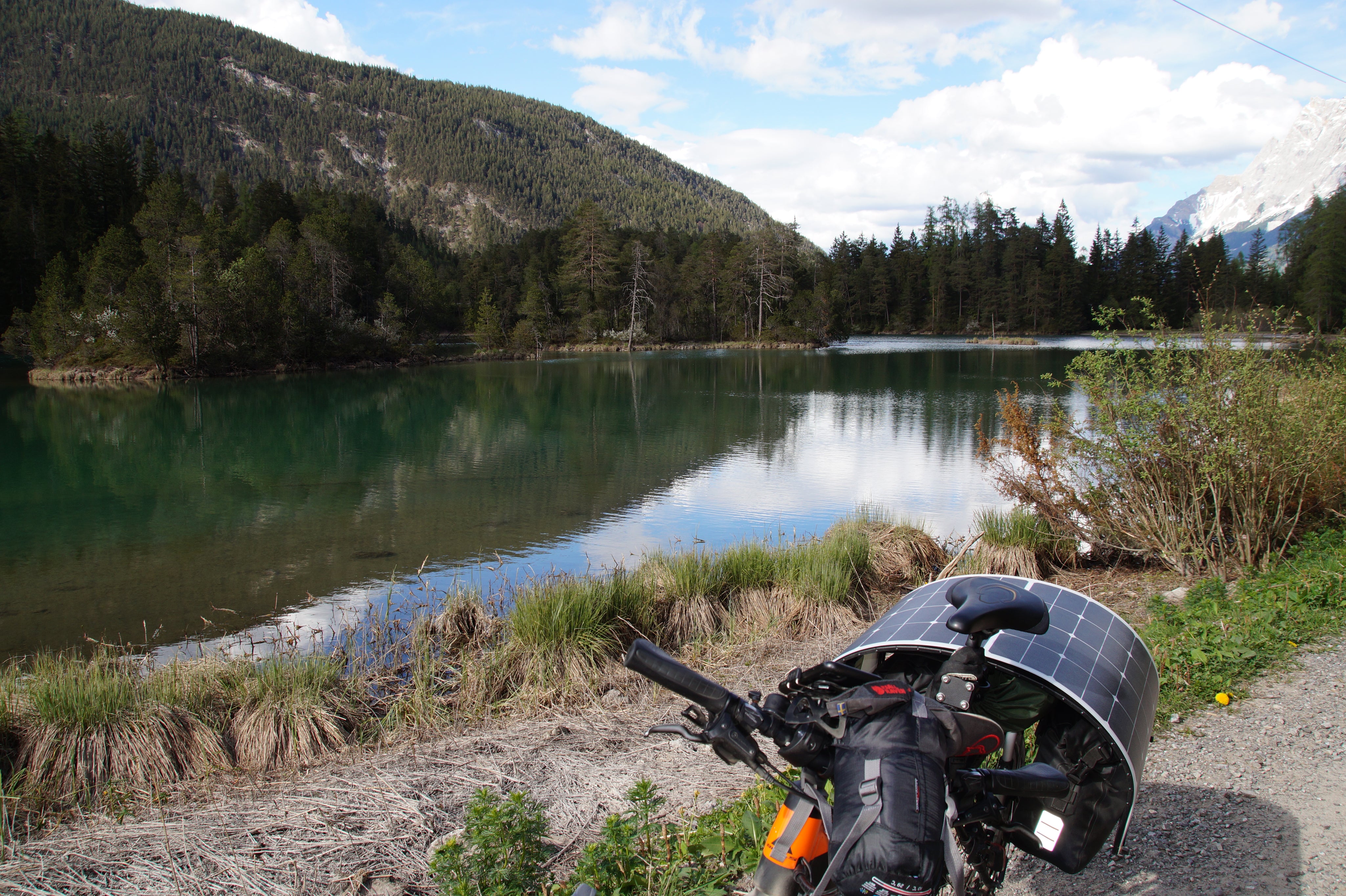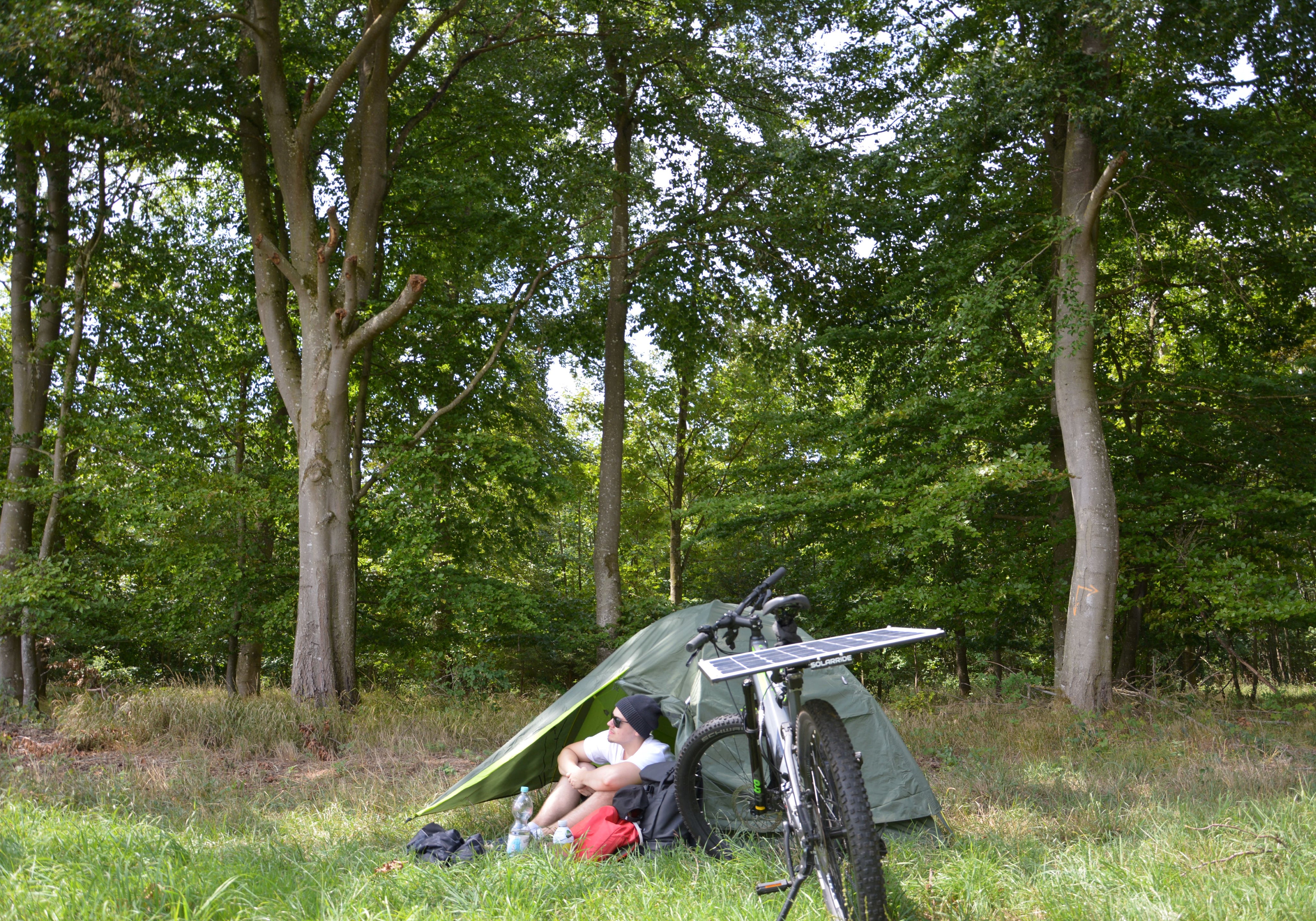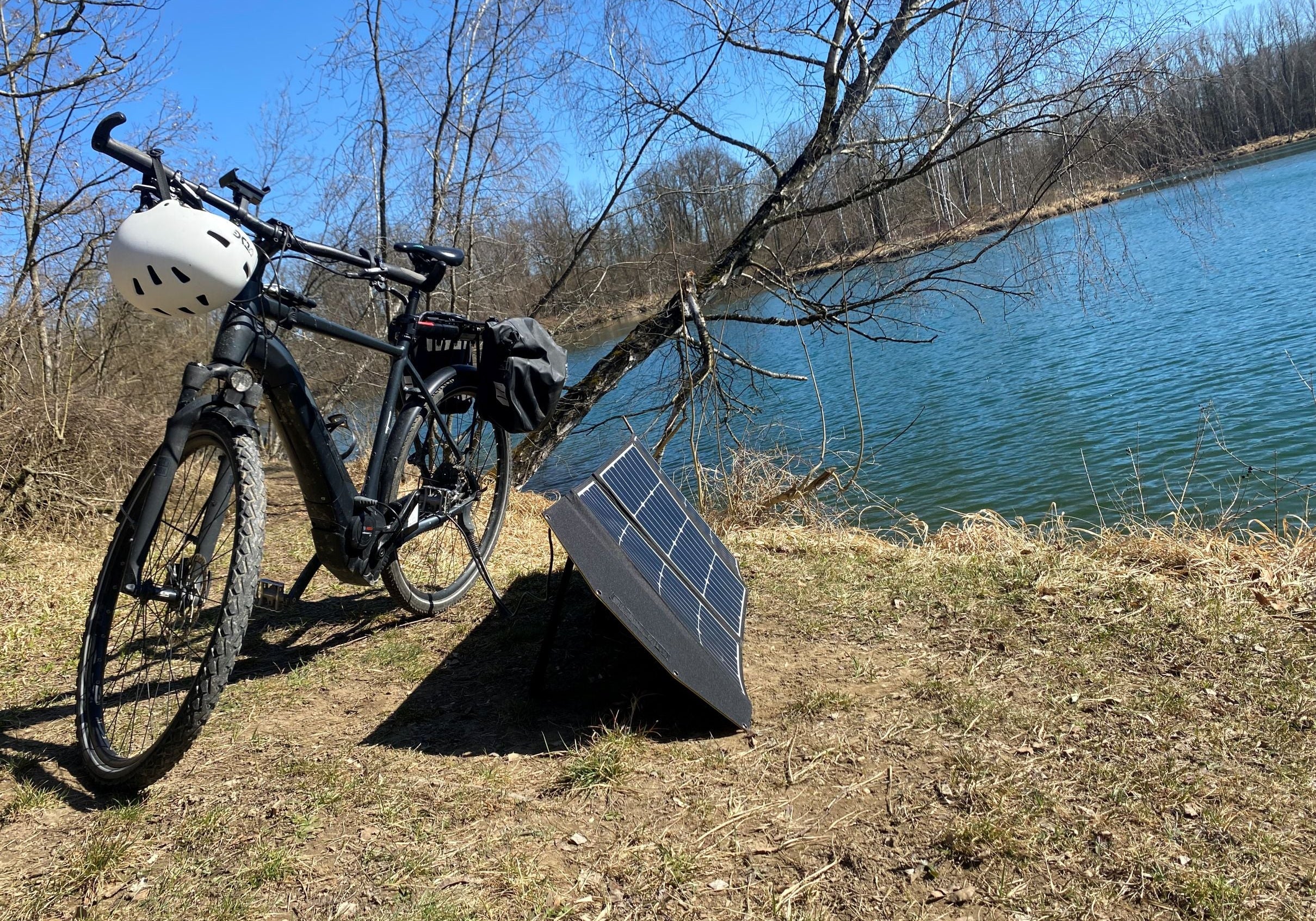The unforgettable crossing of the Alps with the SolarRide 120 WP

Our product is designed to fully meet the demands of demanding cycling trips, and since we are passionate cyclists ourselves, the business trip couldn't have turned out better.
For this reason, at the beginning of May, I packed my e-bike for a six-day cycling trip, mounted the SolarRide 120WP, and set off from Langenau with a motivated friend. Our destination was Lake Garda, 540 km away. We wanted to conquer the Via Claudia Augusta, which the Romans used 2,000 years ago. I will be completing the trip on a Bulls e-bike (550 WH battery) with a Brose motor and will be riding mostly in Eco mode, except on the steep climbs.
For the first stage we had set ourselves the biggest challenge and that was to Füssen with a distance of 140km and an elevation gain of 800m.
The weather was partly cloudy with occasional bursts of sunshine. We planned our tour with Komoot, and it took us through the beautiful Langenauer Ried valley to the Günz reservoir in Waldstetten. Here we took our first break after about 30 km, and I was able to recharge by 15% thanks to the sunshine.

After refreshing ourselves and our e-bikes, we continued on a wonderful cycle path directly along the Günz and through lovely villages for another 35 km.
After a long search, we found a bench right by the Günz River, and we enjoyed our lunch in lush natural surroundings. Fortunately, the sun was shining brightly, and I was able to top up my battery by 20% during my hour-long lunch break.


After setting off to tackle the remaining 70km, the route was favorable, and with the sun constantly breaking through, I was able to almost completely offset the consumption with the battery charge during the ride. By now, after almost 90km, our energy was waning, and we still had 50km to go. Now it was time to grit our teeth and pedal hard.
We'd already used up our provisions, so we absolutely had to stop at a restaurant for a bite to eat. After 110 km, we came across the perfect restaurant and couldn't resist the cheese spaetzle. By the time we'd finished eating, however, it was already 7 p.m., and we still had 30 km to go to our accommodation.
Normally, with all the luggage and the miles, my battery would have been drained by now, but thanks to the sun, I still had 30% left. This 30% and my willpower finally pushed us to our accommodation, where we arrived at 9 p.m., completely exhausted but happy.
Conclusion for the SolarRide 120 WP on a cloudy day with occasional sunshine and 140 km / 800 meters of elevation gain: The charging power when stationary in full sunlight is comparable to the power outlet, and charging while driving also works excellently thanks to the two 60 W solar panels connected in parallel. With all the charges that day, I had an additional 70% of the battery capacity available. However, full self-sufficiency would only be possible with a distance of around 70 km, which would require more charging time while stationary. Using the included power adapter, I was still able to charge my battery for the next day at my accommodation using the SunLight charger.
The next day arrived, and after a hearty breakfast, we set off full of energy for the second stage. Today, the main focus was on elevation gain, and we were to ride from Erkenbolingen near Füssen to Imst. The weather wasn't favorable today; it was very cloudy and rain was forecast. But we didn't let that dampen our spirits and headed for the mountains with big smiles. The route initially followed the Lech River upstream. However, we had been inspired by a mountain bike tour along the Via Claudia, so Komoot led us from the regular road onto a gravel path leading steeply uphill.
At the top, impressive views of the Zugspitze and the limestone cliffs of the Mieminger Range awaited us. After a fun 25 km descent, we stopped for lunch with a beautiful view of the mountains.

Unfortunately, the sun didn't shine. It was heavily overcast, and I could only recharge by about 6% due to the diffused light. After the refreshment, the next climb came, and we rode another 30 km and 400 meters of elevation gain through a beautiful coniferous forest to an inviting bench where the sun greeted us in full force.


Here we were able to refuel, dry our washed clothes, and, most importantly, I was able to recharge by 15% during the 45-minute break thanks to the full sun. After a strenuous climb, we were greeted by a beautiful mountain lake and a few rays of sunshine that came out at the perfect moment. We had a moment to soak up the view, be grateful for nature and the freedom to make the journey.

This made the last 20 kilometers no longer a problem, and after 80 km and 1,000 meters of elevation gain, we arrived at the campsite in Imst, with 40% battery left in the tank. After an amazing pizza, we headed to bed, as the Reschen Pass was on the agenda the next day.
Conclusion for the SolarRide 120 WP on a heavily overcast day with 1 hour of sun and an 80 km route / 840 meters of elevation gain: The solar panel performs significantly less efficiently in the heavy cloud cover, and therefore only 35% of the additional battery capacity was available throughout the day. I was able to recharge most of it during my break in full sun. Complete self-sufficiency is only possible with a 30 km route in this weather. Since the weather forecast for tomorrow was very poor, I fully charged it at the campsite for the next day.
On the third day, a bit of rain awaited us in the morning, which didn't help with packing up the tent, but it wasn't a real headache either. After a ginger shot and a snack at the supermarket, we set off on a beautiful trail that ran directly along the Inn River, surrounded by a mountain panorama. The bike path was perfectly maintained, and we just breezed through the kilometers, even though the weather was very cloudy and rainy.
After about 50 km, we faced the big climb. Unfortunately, Komoot directed us directly to the Reschen Pass, and we wouldn't recommend that to anyone, as riding directly on the road is extremely dangerous. It wasn't until we spoke to another cyclist in Laatsch that we learned that there was another cycle path that bypassed the Reschen Pass. Now we were on the Reschen Pass, we were pushing ourselves and our e-bikes to the limit to get back on a cycle path as quickly as possible. The result was that we arrived in Nauders completely exhausted but safe, and we took a break here. I was able to top up by 10% during the hour-long break, as the weather was unfortunately still poor.

After another 10 km, we reached the highest point and drove along Lake Resia, with a view of the Ortler, South Tyrol's highest mountain, to our accommodation in Laatsch. After a brief stop at the impressive Fürstenburg Castle in Burgeis, we arrived and rewarded ourselves with an excellent meal that evening.

Conclusion for the SolarRide 120 WP on a heavily overcast, sunless day with a 91km route and 1100m elevation gain: On the third day, we actually didn't have a single clear ray of sunshine, which meant I could only recharge to about 20%, and self-sufficiency would only be possible after a 20km route. However, since we include the power pack for inclement weather, I was still prepared for the next day.
The next morning, the sun greeted us, and with a beautiful view of the valley, we enjoyed breakfast in a particularly pleasant way. Today's itinerary included 132km and plenty of downhill riding. The bike path led us charmingly along the Adige River through apple orchards, and the sun didn't let us down that day either.

The Adige River flows through the jewel of South Tyrol, and our route also led us through the heart of the welcoming town of Merano. Here, we first experienced the unique feeling of having traveled to Italy by e-bike and having experienced the entire route. Bolzano lies on our way, and we have plenty more to marvel at as we cycle through the city in sightseeing mode. Gradually, more and more vineyards appear as we approach the South Tyrolean Wine Road.

Today I'm doing a lot of recharging while riding and because I'm feeling a bit under the weather, I'm riding most of the way with almost full support (3 out of 4) instead of at level 1 out of 4 as before.

Despite the initial downhill stretch, the 132 km are a considerable distance, so we ride until dusk, finally arriving in the idyllic village of Lavis, also known for its wine production. Situated on the Avisio stream, Lavis has a charming, typically Italian town center, and in the evening, the local wine bars are always worth a visit.
Conclusion for the SolarRide 120 WP on a sunny day and a 132km ride / 600m descent: We had 7 hours of sunshine that day, so I was able to recharge to around 110% with the charge during the ride and the two longer breaks. This would have made it possible to fully self-sufficient for a 110km ride that day. However, since I was riding with almost full assistance due to my cold, I recharged my e-bike at my accommodation using the included power pack.
The next morning, we were eagerly anticipating the final stage, 95 km and 450 meters of elevation gain, to Bardoliono on Lake Garda. After the first few kilometers, however, we first passed through the important city of Trento, one of the largest cities in the Alps, steeped in history with its cathedral square, the cathedral, and winding alleys.

The route takes us along the Adige River cycle path, which is heavily used by locals due to the weekend. However, the further we climb over the mountains toward Lake Garda, the less bicycle traffic there is. The sun is shining brightly again today, and I can barely manage to drain my battery.

After recharging and refueling, we're already 60km into the final climb, finally getting a view of Lake Garda, separated from us by the mountains. The climb isn't difficult; full of anticipation, we climb the mountains and finally descend with a breathtaking view of Lake Garda. We've actually made it to Lake Garda, and we'll celebrate this evening!

Conclusion on the SolarRide 120 WP on a sunny day with 95 km / 450 meters of elevation gain: On this day, I was fully self-sufficient on the route, as I again completed the journey at level 1 of 4 and recharged a full battery charge.
We are now enjoying another full day at Lake Garda and will then drive the 30 km to Verona to visit the city and take the train home the next morning, which worked out wonderfully.
All in all, the cycling trip was an unforgettable experience that left us wanting more. For future tours, we would aim for a maximum of 100 km per day to enjoy the trip more and have time to fully absorb the surroundings. The charging technology has proven itself more than worthwhile, giving us the freedom to ride with more assistance, cover longer daily distances, and on two days, with fewer kilometers, we wouldn't have even needed to stay in accommodation with an electrical connection. With the triple charging option, we were completely relaxed about the charging infrastructure, as we always had a charging option without having to plan all the charging stations in advance.



